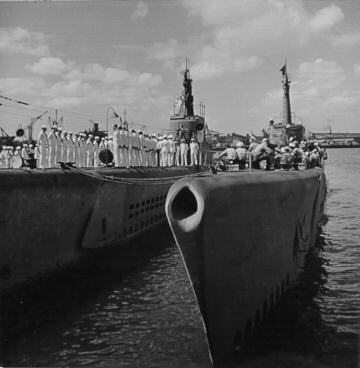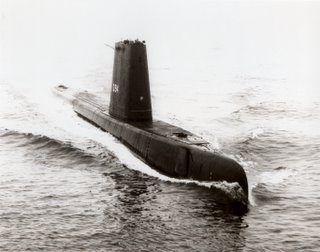_________________________________________________________________
The Shreveport TimesBy
John Andrew Prime
March 01, 2006
Civil War submarines known to once be in Shreveport but unseen since that conflict continue to elude searchers.
"The submarines look like they will stay an enigma for a while," said Ralph Wilbanks, the diver who led underwater efforts that found the Confederate submersible Hunley off Charleston Harbor in 1995. "We have looked in the bayou and we didn't see anything we didn't see last time."
Wilbanks, together with fellow Hunley discoverer Harry Pecorelli III and diver Darrell Taylor, has spent the last week in Shreveport, dragging side-scan sonars and magnetometers in countless lanes on mapped grids on the Red River, Cross Bayou and Cross Lake, looking for nagging mysteries from the Civil War to World War II. They may wind up their dives today.
As with Wilbanks' first visit to Shreveport in 1999, the current survey was underwritten by best-selling author Clive Cussler and his nonprofit, volunteer National Underwater and Marine Agency. Cussler said his decision to send Wilbanks and his crew back to Shreveport was based on "new data where the river changed course ... Apparently nothing was found again."
Wilbanks thinks the submarines were abandoned and salvaged after the Civil War.
"I think it's reasonable to think they may have just melted (them) back down and made steel out of (them)," he said.
Wilbanks and his crew also made scanning runs over the site of the suspected grave of the Civil War warship Grand Duke, out in the middle of Red River just north of Cross Bayou.
They got some hits there. That was where Pecorelli dove Tuesday. Results were inconclusive, with the sources of strong magnetometer readings under tree stumps and driftwood.
"There are some targets in the river and some very strong targets on the Bossier side," said Shreveport cartographer and historian Gary Joiner, whose Blanchard Place office has been the divers' nerve center this visit. "Some of the targets in the river are currently protruding above the channel floor a few feet. The Bossier side is currently very shallow in this area and we could not get the instruments near it."
While here, Wilbanks decided to spend a few days scanning Cross Lake to try to find a World War II B-26 bomber long rumored to have belly-landed and sunk into the muck.
"We decided, since we were coming all the way out here, we'd look for this plane, too," Wilbanks said.
While the Red River work took up most of Thursday and Tuesday, Sunday and Monday were spent running scores of tracks up and down the lake, searching but not finding.
"Finding what you're looking for, that's the most exciting part," said Pecorelli. He's worked with Wilbanks since the mid-1990s.
"Most of the time you find out where things aren't," Wilbanks said. "You very seldom find where things are. The other thing is, you either find it in the first lane or the last lane."
Precedent has shown that these historic treasures do exist and are just waiting to be found.
Several decades ago, a fisherman on the Red River noticed something sticking out of a crumbling bluff. It turned out to be a dugout canoe, several millennia old, and one of the area's richest historical finds.
Known wrecks of Civil War-era vessels include the transport Kentucky, just south of LSU-Shreveport, and the Union ironclad Eastport, near Montgomery.
Friday morning was spent crunching Thursday's data.
Wilbanks and Pecorelli gazed intently at sonar runs through the day, pieced pictures together to present a full view of the targeted river and bayou areas, and correlated these to the magnetometer survey results. At one point the team used seven computers and a plotter to examine the data. The afternoon was spent visiting people and places that might be helpful in the search, including the Cross Lake Patrol, Lowe-McFarlane American Legion Post 14 on the lake, and conferring with Shreveport police Sgt. Mike Day, who once worked with the SPD dive team and knew a B-26 pilot who remembered the bomber.
"Monday, we went back out on the lake and looked at a couple of other areas for the plane," Wilbanks said Tuesday. "We found some cable and potentially an old house site. We surveyed all the areas around Squirrel Point, the area most associated with the airplane, and found nothing."
Monday, Joiner learned from fellow historian Eric Brock that a photograph in a local archive shows the plane silhouetted in the lake. Joiner plans to search for the photo today, and if found, the divers may return to the lake. Otherwise, they'll head back to South Carolina.
Tuesday, Wilbanks said, "we went back to the Red River and dived on three sonar targets. They were like log jams. So we did a little more magnetometer work and sonar work and ruled those out."
Even though the survey didn't turn up the subs or the airplane, it has increased the store of knowledge of the Red River and its tributaries.
For years, Joiner has thought the submarines might have been scuttled in an area near the old Battery Walker, which is now under dry land at what Bossier City calls Cane's Landing. Using ground-penetrating radar might be the next step here, he said, but that area was used as a dump for many years, and items from the intervening 14 decades would shield the Civil War material from detection.
These searches are tremendously important in terms of adding to the store of history, Joiner said.
"We are practicing forensic history. We are using the best technology available today in this research. We are working with some of the best known researchers in the world ... . Shreveport is, at this time, one of the focal points for this advanced research because it was important during the Civil War and the research and development then might exist today. If found, these artifacts will be profoundly important for scholars."
Related link: Visit Clive Cussler's underwater search site,
http://www.numa.net/.
____
www.dofundodomar.blogspot.com www.schnorkel.blogspot.comwww.airplanes-underwater.blogspot.com






















